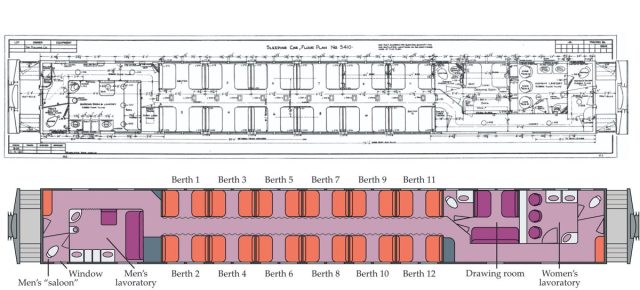On the sixth day of Christmas —
The whereabouts of the documents remains a mystery to this day.
Jennifer Ouellette
–

Enlarge / In 1953, the eminent physicist and H-bomb advocate took an ill-fated overnight train from Philadelphia to Washington, DC, that would indirectly lead to the Robert Oppenheimer security hearing.
Michail_Petrov-96/iStock/Getty Images
There’s rarely time to write about every cool science-y story that comes our way. So this year, we’re once again running a special Twelve Days of Christmas series of posts, highlighting one science story that fell through the cracks in 2020, each day from December 25 through January 5. Today: the story of how physicist John Wheeler once left classified documents about the newly developed H-bomb on a Pullman train.
In the popular science world, physicist John Wheeler is probably best known for popularizing the term “black hole,” although his research spanned a broad range of fields, including relativity, quantum theory, and nuclear fission. He also worked on Project Matterhorn B in the early 1950s, the controversial US effort to develop a hydrogen bomb. In January 1953, Wheeler accidentally left a highly classified document concerning that program on a train as he traveled from his Princeton, New Jersey home to Washington, DC. It was a stereotypical “absent-minded professor” moment, and one with significant national security implications.
Alex Wellerstein told the story in detail late last year in an article in Physics Today. Wellerstein is a historian of science at the Stevens Institute of Technology in New Jersey, where his research centers on the history of nuclear weapons and nuclear history. (Fun fact: he served as a historical consultant on the short-lived TV series, Manhattan.) His forthcoming book, Restricted Data: The History of Nuclear Secrecy in the United States, is slated for publication in April 2021 by the University of Chicago Press.
A self-described “dedicated archive rat,” Wellerstein maintains several homemade databases to keep track of all the digitized files he’s accumulated over the years from official, private, and personal archives. The bits that don’t find their way into academic papers typically end up as items on his blog, Restricted Data, where he also maintains the NUKEMAP, an interactive tool that enables users to model the impact of numerous types of nuclear weapons on the geographical location of their choice.
Wellerstein stumbled across the Wheeler story while examining declassified congressional transcripts from the 1950s, notably from the Joint Committee on Atomic Energy. “It was a very powerful committee in the 1950s,” he told Ars. “There’s all these strange stories that come up, because none of the [committee members] ever thought these things would see the light of day, so they were remarkably frank.” There are even comments in the transcript where members ask why the meeting is being recorded at all, because who would ever read it? “It’s me. I’m the one that’s going to read it one day,” said Wellerstein.
The “Wheeler incident” appealed to Wellerstein because it was rife with colorful details, as well as being of historical interest and relevance. But it was just one account from one person—the Joint Committee’s chief of staff, William Borden, who was fired after the incident—so he started digging around the archives for more information, even filing a FOIA request for Wheeler’s FBI file. That file turned out to be the most useful for the Physics Today article.
“They worked very hard to reconstruct exactly what had happened, so they interviewed everybody a million times,” said Wellerstein. “The FBI ended up being sort of a liaison between Congress, the Atomic Energy Commission, and Wheeler, because those groups weren’t really cooperating with each other.”
No ordinary report
What was it that was so special about those documents Wheeler took with him on the train? “The H-bomb document was no ordinary technical report,” Wellerstein wrote in Physics Today. “It was a bureaucratic weapon aimed directly at its creators’ political enemies.” In 1949, the Soviets detonated their first atomic bomb, and the US lost a major military strategic advantage. Some physicists, led by Edward Teller and Ernest Lawrence, felt the solution was to build a new kind of nuclear weapon: a hydrogen bomb that relied on nuclear fusion, rather than fission, for its devastating explosion (although such a reaction would need to be powered by a fission bomb).
But others, like J. Robert Oppenheimer, former head of the Manhattan Project, objected to the program, deeming it unnecessary. President Harry Truman ultimately sided with Teller and Lawrence, and the Matterhorn B project was born, but physicists remained bitterly divided on the topic. In March 1951, Teller and Stanislaw Ulam came up with an H-bomb design that even opponents of the program acknowledged would likely work. The prototype “Mike” device was successfully detonated in November 1952. But it wasn’t ready for practical use as a military weapon, Wellerstein wrote, given the 80 tons of cryogenic equipment needed to keep its deuterium fuel in a liquid state.
John Wheeler reminiscing about a key breakthrough in nuclear physics that came to him while he was returning home by train, after meeting with Niels Bohr
Declassified (and heavily redacted) version of paper by Teller and Ulam on March 9, 1951: On Heterocatalytic Detonations I: Hydrodynamic Lenses and Radiation Mirrors in which they proposed the staged implosion(Teller–Ulam) design.
The Sausage device of the Ivy Mike nuclear test (yield 10.4 Mt) on Enewetak Atoll, 1952.
US DOE/Public domain.Ivy Mike (yield 10.4 mt) – an atmospheric nuclear test conducted by the U.S. at Enewetak Atoll on 1 November 1952. It was the world’s first successful hydrogen bomb.
National Nuclear Security Administration/Public domain
Meanwhile, a different kind of war was being waged on the political front by H-bomb proponents on the Joint Committee on Atomic Energy, many of whom were still bitter about Oppenheimer’s sharp criticism in particular. It fell to Borden, as chief of staff, to compile an official history of the H-bomb’s development, based on documentary sources, which doubled as a smear campaign against Oppenheimer. He sent a six-page extract of the document to Wheeler in Princeton, so the physicist could check the technical details.
Wheeler took the document on a Pullman sleeper train as he headed back to Washington, DC, and read it overnight—mostly to avoid the added expense of paying for an overnight stay in the hotel. Although he later began to doubt his memory, Wheeler recalled that he put the extract into its white envelope, placed that back inside its manila envelope, put the manila envelope in his suitcase, and then wedged the suitcase between himself and the wall. The porter, Robert Jones, awakened Wheeler at 6:45am as he had requested, and Wheeler took his suitcase to the men’s lavatory at the other end of the train to perform his morning ablutions. Per Wellerstein:
Wheeler left his suitcase on the counter, took the manila envelope with him into the men’s “saloon” (toilet stall), and closed the door. Finding nowhere to put the envelope, he wedged it between some pipes and the wall, just under the window on his right. He used the toilet. He exited the stall, continued washing up—and then realized he had left the envelope wedged against the saloon wall.
At that point two other men were using the wash basins and another man was occupying the toilet stall. Not letting decorum get in the way of security, Wheeler climbed on the washstand and attempted to peer through the metal grate on the toilet door. He could not see the envelope, but he could see the other man on the toilet and could see that he was not reading anything. Wheeler watched him until he finished his business and opened the door, at which point Wheeler ran in behind him and grabbed the manila envelope from behind the pipes. It did not seem tampered with.
But when Wheeler got back to his berth and looked inside the manila envelope, the white envelope containing the classified documents was gone. With the porter’s help, Wheeler searched the train for the missing white envelope, even checking with the station’s lost-and-found on the extremely unlikely chance that someone had turned it in—to no avail. Not even the FBI’s extremely thorough subsequent investigation turned up the missing documents.

Enlarge / Schematic drawing of the Pullman car where John Wheeler spent the night on 6 January 1953.
Newberry Library, Chicago
In fact, those documents were never recovered, and their whereabouts remains a mystery to this day, although there are plenty of speculative theories. Wellerstein personally favors the theory that the porter found the documents and just threw them away rather than reporting the find, because he thought he would be better off pretending he never saw it—although being stolen by a spy is a far more exciting hypothesis. But given the lack of evidence, he thinks the spy scenario is highly improbable.
According to Wellerstein, Wheeler’s misplacing of the classified H-bomb documents happened at the worst possible time, particularly given how the hydrogen bomb was viewed as distinctly different from the first atomic bombs. It was also a technology controlled by secrets as opposed to materials. “It’s not some magical material, and it’s not hard to build,” he said. “It’s just knowing how to arrange it.” This had huge strategic implications for American policymakers and military leaders, who feared the information would fall into Soviet hands, thereby posing an even greater risk to the safety and security of the United States.
“For them, it’s really this life or death situation,” said Wellerstein. “The H-bomb was something they thought they had this big advantage on because the spies of the Manhattan Project didn’t know that much about it. You’ve got the principle of the thing but you don’t actually have any H-bombs in your stockpile. And now there’s this possibility that there’s no advantage whatsoever, if this has fallen into Soviet hands.”
The loss of the documents derailed several political careers, including Borden’s. After being fired from his position, Borden returned to his private law practice, and became a full-blown conspiracy theorist. He had a particular vendetta against Oppenheimer, and his unrelenting campaign against the physicist was one of several factors that led to the infamous Oppenheimer security hearing, which stripped the physicist of his security clearance.
As for Wheeler, he got off easy with a sharply worded letter of rebuke from the Atomic Energy Commission. “He was too valuable as a scientist,” said Wellerstein. “They said they couldn’t punish him without hurting the nuclear program.”
DOI: Physics Today, 2019. 10.1063/PT.3.4364 (About DOIs).

